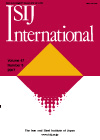
ISIJ INTERNATIONAL
Scope & Guideline
Unlocking Knowledge in Mechanics of Materials for Global Impact
Introduction
Aims and Scopes
- Metallurgical Processes and Innovations:
The journal addresses advancements in metallurgical processes such as steel production, casting, and welding techniques. This includes discussions on novel methodologies and technologies that enhance efficiency and quality in steel production. - Mechanical Properties and Material Behavior:
Research in this area focuses on the mechanical properties of steel and alloys, including strength, ductility, and fracture behavior. Studies often explore how different treatments and alloy compositions affect these properties. - Hydrogen Embrittlement and Corrosion Resistance:
A significant focus on understanding hydrogen embrittlement phenomena and corrosion resistance in various steel grades. This includes studies on the mechanisms, prevention strategies, and impacts of hydrogen on steel integrity. - Inclusion and Defect Engineering:
Investigations into the behavior of non-metallic inclusions and defects within steel materials, and how these affect overall performance and reliability. - Thermodynamic and Kinetic Modeling:
The journal publishes work involving thermodynamic modeling and kinetic studies related to various metallurgical reactions, which are essential for understanding and optimizing processes in steelmaking.
Trending and Emerging
- Hydrogen-related Research:
There has been a notable uptick in research focused on hydrogen's effects on steel, particularly in relation to hydrogen embrittlement, permeation, and mitigation strategies. This is increasingly relevant given the industry's push towards hydrogen as a cleaner energy source. - Advanced Characterization Techniques:
Emerging techniques such as in-situ neutron diffraction, synchrotron X-ray imaging, and advanced computational modeling are gaining prominence. These methods enhance the understanding of microstructural changes and mechanical properties at the atomic level. - Sustainability and Environmental Impact:
Research addressing the environmental aspects of steel production, including carbon capture, utilization of waste materials, and development of low-emission processes, is becoming increasingly relevant as the industry seeks to reduce its carbon footprint. - Machine Learning and AI in Metallurgy:
The integration of machine learning and artificial intelligence into materials science and metallurgical processes is on the rise, with applications ranging from predictive modeling of steel properties to optimizing production processes. - Multi-material and Hybrid Structures:
There is growing interest in the development and characterization of multi-material systems and hybrid structures, particularly in automotive and aerospace applications, where weight reduction and enhanced performance are critical.
Declining or Waning
- Traditional Steelmaking Techniques:
Research centered around conventional steelmaking methods, such as basic oxygen steelmaking, has decreased as newer technologies and hybrid methods gain traction. - Low-Carbon Steel Innovations:
While low-carbon steels have been a significant area of interest, there seems to be a waning focus on traditional low-carbon innovations as the industry moves towards more advanced, high-strength materials. - Static Mechanical Testing Methods:
The reliance on static mechanical testing methodologies appears to be diminishing, with a shift towards more dynamic and real-time testing approaches that provide insights into material behavior under operational conditions.
Similar Journals

RARE METAL MATERIALS AND ENGINEERING
Transforming Ideas into Engineering SolutionsRARE METAL MATERIALS AND ENGINEERING is a vital academic journal dedicated to advancing the fields of materials science, engineering, and metallurgy. Published by the NORTHWEST INST NONFERROUS METAL RESEARCH in China, this journal has been an essential resource for researchers and professionals since its inception in 1993. With a focus on rare metals and their engineering applications, the journal addresses contemporary issues and innovations in materials chemistry and electronic engineering, providing insights into the properties and uses of advanced materials. Although it currently falls within the Q4 category for several categories, including Electrical and Electronic Engineering and Materials Chemistry, its commitment to quality and relevance in the field is evident. The journal offers a platform for researchers to share their findings with the scientific community, fostering collaboration and knowledge exchange in an important area of study. Researchers and students interested in exploring the latest in rare metal technologies and engineering methodologies will find this journal a valuable addition to their academic library.

JOM
Pioneering research for a sustainable future.JOM, published by Springer, is a leading academic journal dedicated to advancing research in the fields of Engineering and Materials Science. With an ISSN of 1047-4838 and an E-ISSN of 1543-1851, JOM has established itself as a reputable source of scholarly articles, contributing significantly to the understanding and development of materials and their applications in engineering. As of 2023, it ranks in the second quartile (Q2) in both the Engineering (miscellaneous) and Materials Science (miscellaneous) categories, showcasing its influence and academic rigor. With a Scopus rank of #84 in General Engineering and #212 in General Materials Science, JOM is positioned as a vital resource for academics and professionals aiming to stay abreast of the latest research trends and innovations. Although the journal does not currently offer open access options, its commitment to quality publishing continues to make it an essential read for researchers and students alike, fostering a collaborative environment for growth and discovery in the materials science community.

METALLURGIA ITALIANA
Advancing Knowledge in Metals and AlloysMETALLURGIA ITALIANA, an esteemed journal published by the ASSOCIAZIONE ITALIANA METALLURGIA, specializes in the fields of condensed matter physics, mechanics of materials, and metals and alloys. With a history spanning from 1969 to 2024, this Italian journal has consistently contributed to the scholarly conversation surrounding metallurgical sciences and materials engineering. Despite its Q4 ranking in several categories, the journal provides a critical platform for emerging research and advancements in metallurgy, encouraging interdisciplinary dialogue among academics, professionals, and students. Readers can benefit from valuable insights into the latest developments and applications in the field, supported by the journal's commitment to fostering academic rigor and innovation. While access options currently do not include open access, METALLURGIA ITALIANA remains a cherished resource for those dedicated to exploring the nuances of material properties and applications.
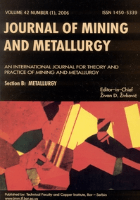
Journal of Mining and Metallurgy Section B-Metallurgy
Pioneering advancements in metallurgy and materials sciences.Journal of Mining and Metallurgy Section B-Metallurgy is a prominent open-access journal published by the Technical Faculty, Bor-Serbia. Established in 2002, the journal has become a vital platform for disseminating high-quality research in the fields of metallurgy, geotechnical engineering, and materials sciences. With an E-ISSN of 2217-7175, the journal has successfully converged its publication years from 2007 to 2024, indicating its commitment to ongoing academic discourse. The journal is currently ranked Q3 in multiple categories including Geotechnical Engineering and Engineering Geology, Materials Chemistry, Mechanics of Materials, and Metals and Alloys, reflecting its importance in academic research and professional practice. With a Scopus rank that positions it within the 30th percentile across various related disciplines, the Journal of Mining and Metallurgy Section B-Metallurgy serves as an invaluable resource for researchers, professionals, and students who seek to explore cutting-edge advancements in metallurgy and materials science. It provides vital insights that contribute to the development and innovation in these essential fields.
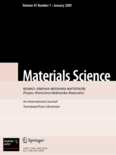
MATERIALS SCIENCE
Innovating Insights in Engineering and Physics.MATERIALS SCIENCE, a prominent journal published by SPRINGER, serves as a vital resource for researchers, professionals, and students in the fields of materials science, mechanical engineering, and condensed matter physics. With its ISSN 1068-820X and E-ISSN 1573-885X, this journal has been dedicated to sharing innovative research since its inception in 1993, and it continues to publish groundbreaking findings through 2024. Although it operates as a traditional subscription-based journal, its ranking in the Q3 quartile across multiple scientific categories, including Condensed Matter Physics, Materials Science, Mechanical Engineering, and Mechanics of Materials, signifies its relevance and impact in the academic community. Notably, its Scopus classifications reveal a competitive standing among its peers, ranking within the 25th to 33rd percentiles across various engineering and physics disciplines. The journal remains a key platform for disseminating valuable insights, fostering collaboration, and advancing the understanding of materials science.
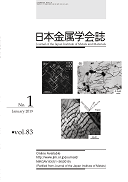
Journal of the Japan Institute of Metals and Materials
Bridging science and application in materials technology.Journal of the Japan Institute of Metals and Materials (ISSN: 0021-4876, E-ISSN: 1880-6880) serves as a vital academic platform under the esteemed auspices of the Japan Institute of Metals & Materials. This journal, with a rich publication history dating back to 1937, focuses on advancing knowledge in the fields of metallurgy, materials science, and engineering, making it an important resource for researchers, professionals, and students alike. Although the journal has been categorized in Q4 quartiles across several subject areas, including Condensed Matter Physics and Materials Chemistry, it plays a critical role in disseminating essential findings and fostering discussion regarding innovations in metal and materials research. Notably, the journal operates without open access, which encourages targeted readership engagement through its curated content. Based in Japan, it continues to contribute significantly to the academic community by bridging the gap between scientific inquiry and practical application in materials technology.

METALS AND MATERIALS INTERNATIONAL
Exploring innovative breakthroughs in metals and materials.METALS AND MATERIALS INTERNATIONAL, published by the Korean Institute of Metals and Materials, is a prestigious journal dedicated to the advancement of research in the fields of materials science and engineering. With an ISSN of 1598-9623 and a robust e-ISSN of 2005-4149, this journal has established itself as a crucial platform for disseminating innovative findings and key advancements that span condensed matter physics, materials chemistry, mechanics of materials, and the technology of metals and alloys. Its Q1 rankings in multiple categories attest to its high impact and relevance in the academic community, placing it among the top journals in its fields with Scopus rankings that reflect a strong international footprint. Here, researchers, professionals, and students can access cutting-edge research and insights, fostering collaboration and exploration of new materials and their applications. With a commitment to excellence and a convergence of knowledge from 1996 to 2024, METALS AND MATERIALS INTERNATIONAL continues to enhance our understanding of materials and their transformative impact on technology and engineering.
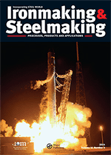
IRONMAKING & STEELMAKING
Pioneering Research in Metallurgical EngineeringIRONMAKING & STEELMAKING is a premier peer-reviewed journal published by SAGE Publications Inc, dedicated to advancing the field of metallurgical engineering and materials science. With a notable ISSN of 0301-9233 and an E-ISSN of 1743-2812, this journal has established itself as a significant platform for disseminating high-quality research on ironmaking processes, steel production, and associated technologies. Covering a broad scope of topics, it is indexed in the top quartiles (Q2) in Materials Chemistry, Mechanical Engineering, Mechanics of Materials, and Metals and Alloys for 2023, underscoring its pivotal role in these disciplines. Since its inception in 1974 and continuing through 2024, IRONMAKING & STEELMAKING attracts a global audience of researchers, professionals, and students, contributing valuable insights and innovations in the field. Although not an open-access publication, subscribers can access essential findings that shape the future of metallurgy and steelmaking. This journal not only serves as a repository of knowledge but also as a beacon for ongoing research and technological advancement, making it a must-read for those passionate about materials science.
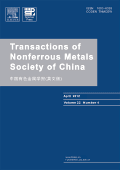
TRANSACTIONS OF NONFERROUS METALS SOCIETY OF CHINA
Connecting professionals with cutting-edge research in metallurgy.TRANSACTIONS OF NONFERROUS METALS SOCIETY OF CHINA, published by Elsevier, is a premier academic journal that serves as a vital platform for researchers and professionals specializing in materials science, condensed matter physics, geotechnical engineering, and engineering geology. Established in 1994, this esteemed publication has maintained a robust focus on the latest developments in the nonferrous metals sector, reflecting its significant impact in the field with a Q1 categorization across multiple disciplines. With impressive Scopus rankings—placing it in the top 20% of journals in relevant categories—this journal is recognized for its quality and rigor, providing critical insights into metals and alloys, materials chemistry, and their applications. The non-open access format ensures a dedicated readership among professionals and academics seeking substantial and authoritative research articles. By fostering knowledge exchange, the journal strives to advance the understanding and application of nonferrous metals, making it an essential resource for anyone involved in material innovations and engineering solutions.
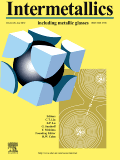
INTERMETALLICS
Pioneering Research in Intermetallic CompoundsINTERMETALLICS, a prestigious journal published by ELSEVIER SCI LTD in the United Kingdom, has been a vital resource in the fields of Materials Science, Mechanical Engineering, and Chemistry since its inception in 1993. Renowned for its rigorous peer-review process and commitment to high-quality research, this journal enjoys an impressive position within the top quartile (Q1) rankings of its categories, signifying its influence and esteem in the academic community. With a particular emphasis on the study of intermetallic compounds and their applications, INTERMETALLICS attracts groundbreaking research and innovative contributions that push the boundaries of knowledge in metals and alloys, as well as mechanics of materials. Researchers looking for a platform to disseminate cutting-edge findings will find this journal an exemplary choice, further enhanced by its commendable Scopus rankings that illustrate its widespread recognition and relevance. Though it does not currently offer Open Access options, the journal remains committed to advancing the field through selective publication of impactful research, making it an essential reference for researchers, professionals, and students alike interested in the dynamic interplay between materials and engineering.